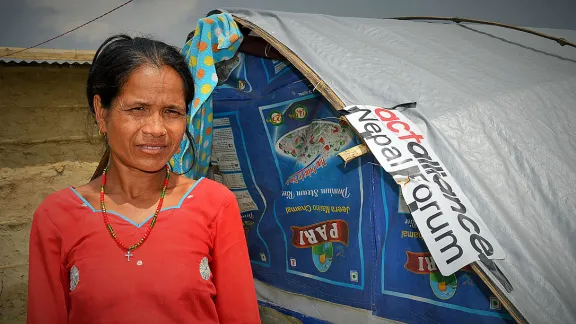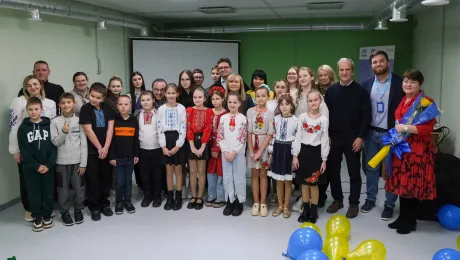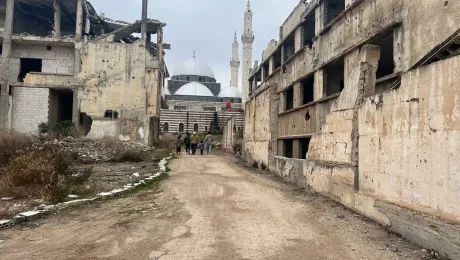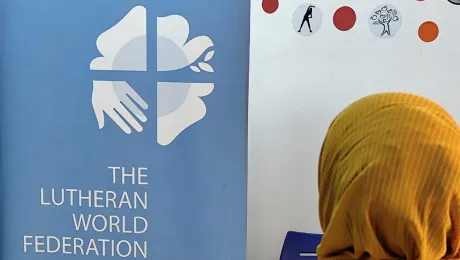
Makeshift houses of plastic sheets and tarpaulins are the only protection against the rain for many people. Photo: LWF/ Lucia de Vries
“An unfolding disaster”
KATHMANDU, Nepal / GENEVA, 14 July 2015 (LWI) - School is over in Dunche, the headquarters of Rasuwa district, and 190 displaced children wait in a makeshift classroom for the rains to stop. The school is an assortment of tents, with foam mattresses as the only furniture. The floors have turned into mud and the children look disheveled. The rains don’t stop, and half an hour later the students run to their shelters below the bazaar, soaked to the bone.
The arrival of monsoon used to be a happy moment for the Nepalese, as it marked the planting of rice on water-fed fields and terraces. After the 25 April earthquake however, the rainy season mostly brings fear and discomfort: an estimated 2.5 million people are still living in temporary shelters.
Animals crawl into shelters
“Last night my shelter was flooded. Stray dogs and frogs came to take refuge under the bed. My feet are swollen and I am unable to work,” says Goma Paryar (40) from Indreni. Goma lives with six relatives in a temporary shelter, a single room which is actually one big tent. Living with them is their daughter and her baby boy who was born a month before the earthquake.
Although Goma feels insecure and unwell since the monsoon started, she is better off compared to her community members. Most people in the Indreni settlement are Dalit or artisans and live under tarpaulins provided by the ACT Alliance, the humanitarian relief network of which the LWF is a member. Goma was able to take out a USD 218 loan and buy zinc sheets for a more durable shelter. She used the sheets for a stronger roof and tarpaulins to create protective walls.
LWF Nepal is providing transitional shelter materials to the community of Indreni, but supplies are short. “The Nepalese industry cannot meet the demands. We order zinc sheets from India but they take at least three weeks to arrive,” Dr Prabin Manandhar, Country Director of the LWF Nepal says.
Distributing the sheets is another challenge. “Roads are blocked and there is the constant danger of landslides. Trucks loaded with relief materials get stuck resulting in more time loss,” Dr Manandhar explains. “It’s a race against time to provide the communities with zinc sheets and other relief materials needed to stay safe and healthy during monsoon.”
Unfolding disaster
The 2015 monsoon has been termed as ‘an unfolding disaster’ by the Nepali government and aid organizations alike. According to the mountain development agency ICIMOD more than 3,000 landslides were triggered by the earthquake. The agency also keeps track of large mass movements created by the ongoing aftershocks. Countless settlements are at risk.
“The government is coming up with a relocation plan for the people at risk but reaching out to scattered groups of displaced people is not an easy task for aid agencies like us,” says Manandhar.
In the densely populated temporary housing sites, the risk of epidemic waterborne disease outbreaks such as cholera is high. Apart from setting up water tanks and emergency toilets and showers, LWF staff together with the Nepal ACT Alliance Forum members hand out hygiene kits with water purification tablets, soap and sanitary towels for women.
Lactating and pregnant women are most vulnerable during monsoon, agrees Prabin Manandhar. “Women and children generally struggle to get access to nutritious food and health services.”
At Goma’s shelter, Radhika has just returned with her baby boy. She used the muddy village path to reach the health post for the child’s monthly check up. The boy looks healthy and flashes a big, happy smile. With the support from LWF Nepal, families like Goma’s stand a much better chance to stay safe and healthy during the rainy season.
In the immediate response to the 2015 earthquake, LWF Nepal with the support of ACT Alliance members supported over 110,000 families with emergency relief. The organization is committed to help families in five affected districts to rebuild their lives through food security, shelter, water and sanitation and psychological assistance, and link this with long-term development.
Contribution by Lucia de Vries, Nepal. Edited by LWF Communications
Donate to the LWF Nepal emergency
Visit the Nepal earthquake response page, the Nepal program page and the Nepal program site


